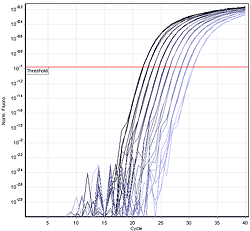qPCR – one of the most powerful and sensitive gene analysis techniques available
The Quantitative Polymerase Chain Reaction (qPCR) is one of the most powerful and sensitive gene analysis techniques available and is used extensively in industrial, academic and diagnostic labs.
Historically, quantitative analysis of DNA/RNA has relied on Southern/ Northern blot hybridisation or conventional end-point PCR. To perform these techniques, a sample of unknown concentration is estimated by comparing the intensity of the amplified band on a gel or blot after a PCR reaction to standards of a known concentration. However there are many limitations to these methods which qPCR has overcome.
The qPCR reaction is performed on a thermal cycling instrument that uses fluorescence detection chemistry to monitor the amount of DNA present in each cycle of the PCR reaction. This is often referred to as Real-Time analysis. As the amount of target DNA in the reaction increases, so will the amount of fluorescence emitted from the marker. By comparing the normalised fluorescence of known standards against the PCR cycle number, the amount of DNA in an unknown sample can be accurately determined.
One-Step RT-PCR can also be performed in real time (qRT-PCR). This technique offers the most sensitive and convenient method of quantifying gene expression.
The Advantages of qPCR
• Time Saving: No need to run a gel. The data is quantified by the instrument as the PCR reaction progresses.
• Increased Sensitivity: Can detect low abundance templates that would not normally be visualised by conventional gel-based methods.
• Increased Accuracy: Readings are taken during exponential phases of the PCR reaction. Therefore there will be no bias from limiting reagent concentrations (figure 1.3.1).
• Reduced Risk of Contamination:The closed tube format reduces the exposure of the reaction to contaminants.

